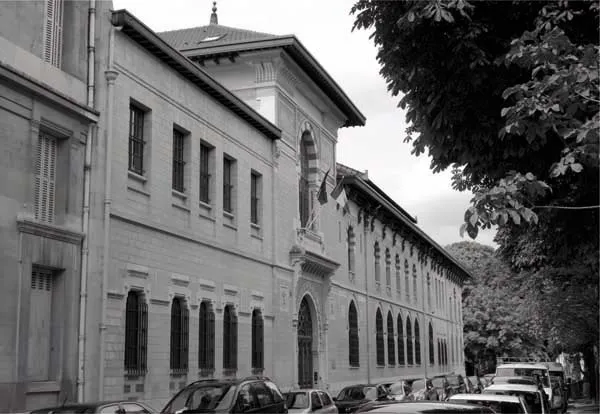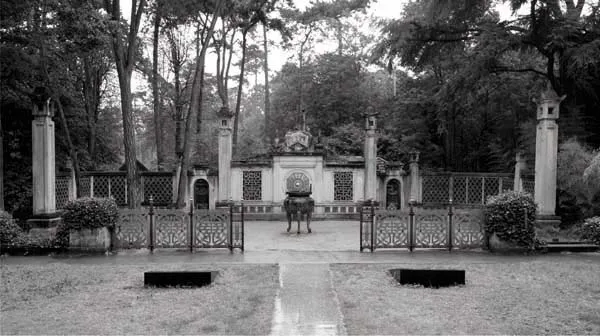![]()
Part I
Colonial spaces in postcolonial metropoles
![]()
2
Old colonial sites and new uses in contemporary Paris
Robert Aldrich
The built landscapes of France, and other countries in Europe, bear both the visible and subliminal traces of colonialism and its legacy: dedicated colonialist buildings and others with a direct connection to the Empire, monuments, war memorials, statues, and graves, and architectural and design motifs. In the early twentieth century, France claimed the world’s second largest overseas empire, encompassing eleven million square kilometers in Africa, Asia, and islands of the Caribbean, Indian Ocean, and Pacific, and French citizens and subjects numbered one hundred million. Promoters of colonial expansion and rule hoped that marking the country with stone, bronze, or marble testimonials to France’s prowess in conquering an empire and its proclaimed “genius” in ruling the outre-mer and fulfilling its mission civilisatrice would galvanize popular support and manifest France’s imperial vocation. The sites created ranged from the modest tombs of now largely forgotten explorers to grandiose purpose-built structures such as a colonial museum in Paris. A flâneur in Paris, and other cities, especially those linked with the colonies, such as Marseille, Bordeaux, Lyon, La Rochelle, Fréjus — and many other places — easily stumbles across reminders of the colonial past, both those that have survived from the colonial period and a few that have subsequently been erected.1
That colonial past has been much contested in recent years, though most of France’s colonies had already gained independence by 1960. New revelations, around the year 2000, about torture during the Franco-Algerian War of 1954–62 ripped open scars left from one of the most divisive conflicts in French history. Debates about the place of Muslims in contemporary society and Islamic cultures in France (such as the practice of wearing Muslim headscarves and burqas by women) relate directly both to channels of migration from Africa established under colonialism and age-old French perceptions of the Muslim and Islamic world. Exhibitions, films and television programs, speeches, and public forums have brought the French face to face with a colonial record that many would have preferred to be quietly filed away. The activism of diasporic groups in France has linked contemporary problems of discrimination and xenophobia to colonial attitudes and behaviors, and politicians and activists of all stripes have tried to deploy the issue of colonialism to their advantage.2
Old and new sites connected with French overseas expansion and decolonization, not surprisingly, have become significant stakes in debates and public policy in the postcolonial age. One question was what to do with sites that no longer served their original function and whose triumphalist colonialist message and style became increasingly inappropriate and uncomfortable.3 Some statues were shuffled off to obscure locations, others moldered away where they stood. Heritage considerations and architectural or artistic value have made it impossible to demolish especially significant sites, and they were often repurposed. For example, the former École Coloniale, built in the Moorish style just outside the Jardin du Luxembourg in the 1880s to train civil servants for the Empire, ceased to enroll new students in the early 1960s, and was later turned into a training institute for students from overseas, many from France’s former colonies [Figure 2.1]. The vast ceiling painting in the institute’s library, showing an allegorical figure of France receiving the homage of maidens representing various regions of the French Empire, remains as a reminder of the ideology behind the institute and of France’s continued engagement, neocolonial or not, with its former possessions.4
This chapter explores in greater detail the “recycling” of three other sites in Paris, suggesting that efforts to repurpose them form part and parcel of France’s difficult, and not always successful, attempt to come to terms with its colonial past. The inventory from which the selection could be taken is a lengthy one, from the old colonial ministry in the Rue Oudinot (which still houses the ministry in charge of France’s remaining départements et territoires d’outre-mer) to the seminary and chapel of the Société des Missions Étrangères in the Rue du Bac (still the headquarters of the missionary society founded in the mid-1600s, and host to a museum of French overseas evangelization) and many others, both imposing and diminutive.
Figure 2.1 The former École Coloniale, Paris (Yvon, 1895). Primary façade detail. Photograph 2014. Source: Daniel E. Coslett.
THE JARDIN COLONIAL
In the commune of Nogent-sur-Marne, at the eastern edge of the Bois de Vincennes — the park where a grand Exposition Coloniale would take place in 1931 — the French at the very end of the nineteenth century set up the Jardin Botanique Colonial. Its mandate was to study plants from the French colonies to determine which ones might be profitably transplanted from one colony to another or acclimatized to the metropole. Tropical agricultural commodities provided a mainstay of colonial business, with long-established markets for such products as sugar and coffee, and developing ones for others, like the rubber that was finding new value for bicycle and automobile tires. The colonial botanical garden also trained agronomists for colonial work, collecting specimens of tropical hardwoods in its xylothèque (wood specimen library) and avidly promoting France’s colonial mission. The grounds of the garden included large greenhouses, laboratories, teaching rooms, a library, and administrative buildings. The garden had links with other scientific institutions, such as the Muséum National d’Histoire Naturelle (National Museum of Natural History), and groups within the “colonial lobby,” the informal network of political, commercial, scholarly, and other figures who served as boosters for the French Empire.5
The Jardin Botanique Colonial fulfilled its function dutifully, and in 1907 organized a colonial exhibition that highlighted the wealth of the plant kingdom in France’s colonies, the commodities (and financial returns) that tropical agriculture brought to France and the Empire, and the agronomical research being undertaken by its staff and students. The fair, which followed a larger Exposition Coloniale held the previous year in Marseille — a city that prided itself on being France’s “portal to the East” and self-appointed colonial capital — was one in a series of colonial fairs held in a number of French cities in the early twentieth century. The Vincennes fair drew on the Marseille precedent, and indeed some of the old pavilions from Marseille were disassembled and transferred to Paris. Another colonial exhibition in Marseille, in 1922, also produced the gift of disused buildings for the Vincennes site. With a star-and-crescent topped pavilion that had hosted Tunisia’s display, another with vaguely Indochinese motifs, and a house in the style of equatorial Africa, the Jardin Botanique Colonial began to look more and more like a colonial theme park [Figure 2.2].
Many soldiers from the colonies fought and died for France in the First World War, and the botanical garden was commandeered as a hospital for the wounded among them during the conflict; a (temporary) mosque set up for Muslims was one of the first officially recognized Islamic places of worship in France. The botanical garden thus seemed a suitable place to erect memorials in honor of the soldiers after the war. The most impressive was a Vietnamese dinh, a communal hall, constructed in Vietnam and transported to France, where it was placed within a copse of bamboo, facing a huge incense urn and ceremonial screen [Figure 2.3]; inside the edifice was a rescript from the Vietnamese emperor, who visited the site when he toured Paris in 1922.6 Nearby was a memorial to Christian soldiers from Vietnam and Cambodia who had died for France during the First World War. An eagle stood atop the Malagasy memorial, symbol of the dynasty of the Imerina kingdom (which the French had abolished when they made Madagascar a colony during the 1890s). A large stone monument depicting a woman and child looking sadly towards the graves of their loved ones honored African soldiers, and there was also a stele in memory of the tirailleurs sénégalais, the troops from western Africa who had made a dramatic impression on the French with their valor during the war.
Figure 2.2 The Jardin Botanique Colonial, Paris. Photographs 2016. Source: Daniel E. Coslett. The 1922 Tunisian pavilion and statue of Eugène Étienne (A, top). Fragments of Belloc’s monument “to the glory of French colonial expansion” (B, bottom).
Figure 2.3 The ceremonial screen and incense urn opposite Vietnamese dinh within the Jardin Botanique Colonial, Paris. Photograph 2016. Source: Daniel E. Coslett.
Over the next forty years, the botanists and agronomists at the Jardin Botanique Colonial continued their work, and old soldiers, military and colonial dignitaries, and representatives of diasporic communities regularly gathered for remembrance services at the memorials. The winding down of the Empire and the reorganization of research and teaching institutions, however, meant that many functions of the garden were transferred to other centers, and the garden lost its raison d’être. While some scientific work continued, the site from the 1970s suffered worsening disrepair. The old exhibition pavilions were left vacant and untended, though sometimes occupied by squatters. The Vietnamese dinh burned — though it is uncertain whether arson was involved or whether the conflagration was accidental. A hailstorm shattered roofs of the greenhouses. To a visitor in the early 2000s, the site seemed a dramatic representation of the ruins of empire. Toppled and broken statuary once meant to adorn a monument “to the glory of French colonial expansion” (which, in fact, was never erected) lay in the overgrown forest, buildings were decrepit with broken windows, sagging verandas and holes in roofs, and a statue of Eugène Étienne, the leader of the colonial lobby, stood forlornly surveying the remains of the garden and the vanished colonies [see Figure 2.2]. A Vietnamese memorial house had nevertheless been reconstructed, the striking vermilion walls of the small edifice standing against the green stands of bamboo offering an exotic and touching reminder of Indochine Française and the service of its soldiers in the world wars — though subliminally also an intimation of the long war of independence fought by a later generation of Vietnamese against the French. The whole garden remained ...



